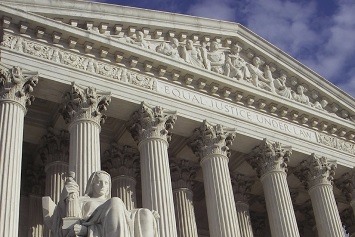Brett Kavanaugh has been announced as President Donald Trump’s choice to replace Anthony Kennedy on the bench of the U.S. Supreme Court. Here’s a brief summary of the judicial nominee’s decisions, rulings, and court opinions on various EHS-related cases in recent years on the D.C. Circuit.

Kavanaugh has served as a judge on the U.S. Court of Appeals for the D.C. Circuit since 2006, 3 years after he was nominated for the position by President George W. Bush. Kavanaugh had worked in the Bush administration advising the president on choices for the federal courts. His decisions were viewed by Senate Democrats as political, resulting in the extended period of debate. Following negotiations between Democrat and Republican senators, the Senate confirmed Kavanaugh in a 57–36 vote. He was sworn in as a member of the D.C. Circuit by Justice Kennedy.
Senate Majority Leader Mitch McConnell said the chamber will vote on Kavanaugh’s nomination this fall before the midterm elections. Before that, Kavanaugh will need to endure what are expected to be bruising confirmation hearings. Some questions directed at Kavanaugh may arise from the following environmental and worker safety rulings in which he participated in the D.C. Circuit.
White Stallion Energy Center v. EPA, April 15, 2014
States, industry, and environmental groups challenged EPA’s 2012 Maximum Achievable Control Technology (MACT) rule to regulate emissions of mercury and other hazardous air pollutants from coal- and oil-fired electric power plants. The industry argument was that the Agency had not met its obligation under the Clean Air Act (CAA) to find that the regulation was appropriate and necessary. Environmental groups contended the rule was insufficiently stringent. The court ruled in EPA’s favor. Kavanaugh agreed that EPA’s action should be upheld but in a separate opinion dissented from the majority’s view “to exclude consideration of costs in determining whether it is ‘appropriate’ to impose significant new regulations on electric utilities.”
“To be sure, EPA could conclude that the benefits outweigh the costs. But the problem here is that EPA did not even consider the costs. And the costs are huge, about $9.6 billion a year—that’s billion with a b—by EPA’s own calculation,” said Kavanaugh.
EME Homer City Generation v. EPA, August 21, 2012
Various states, local governments, industry groups, and labor organizations petitioned for review of EPA’s Cross-State Air Pollution Rule (CASPR), which implemented CAA’s Good Neighbor provision. Writing for the majority, Kavanaugh agreed with petitioners that the rule exceeded EPA’s CAA authority for two reasons. Kavanaugh wrote:
“First, the statutory text grants EPA authority to require upwind States to reduce only their own significant contributions to a downwind State’s nonattainment. But under the Transport Rule, upwind States may be required to reduce emissions by more than their own significant contributions to a downwind State’s nonattainment. EPA has used the good neighbor provision to impose massive emissions reduction requirements on upwind States without regard to the limits imposed by the statutory text.
“Second, the Clean Air Act affords States the initial opportunity to implement reductions required by EPA under the good neighbor provision. But here, when EPA quantified States’ good neighbor obligations, it did not allow the States the initial opportunity to implement the required reductions with respect to sources within their borders. Instead, EPA quantified States’ good neighbor obligations and simultaneously set forth EPA-designed Federal Implementation Plans, or FIPs, to implement those obligations at the State level.”
Coalition for Responsible Regulation v. EPA, December 20, 2012
The case involved industry challenges to EPA’s 2010 Tailoring Rule and Timing Rule, which for the first time included greenhouse gas (GHG) emissions in the Agency’s Prevention of Significant Deterioration (PSD) regulations. The rules changed the PSD and Title V pollution thresholds, which, according to the petitioners, was impermissible under the CAA. A D.C. Circuit panel denied the petitions. Petitioners requested an en banc hearing, which, in this decision, the court denied. Kavanaugh dissented, writing:
“Our job as a court is … to ensure that EPA has acted within the authority granted to it by Congress. In this case, I conclude that EPA has exceeded its statutory authority.
“In particular, the question is whether the term ‘air pollutant’ here covers not just the NAAQS pollutants, which can cause breathing problems or other health issues, but also greenhouse gases such as carbon dioxide, which contribute to global warming.
“EPA chose the broader interpretation of ‘air pollutant,’ thereby greatly expanding the reach of the Prevention of Significant Deterioration statute. But that broader interpretation has a glaring problem, as EPA itself recognized. In the context of the Prevention of Significant Deterioration statute, EPA’s broader interpretation would not mesh with other provisions of the statute and would lead to absurd results.”
Mingo Logan Coal Company v. EPA, April 23, 2013
Mingo petitioned the court to invalidate EPA’s use of Clean Water Act (CWA) Section 404(c) to veto two sites the company wanted to use for disposal at its mountaintop mine in West Virginia. The company argued that EPA’s withdrawal of the specified sites was illegal because the Agency lacks statutory authority to withdraw site specification after the U.S. Army Corps of Engineers issued a permit that authorized use of the sites for disposal. A district court judge agreed with Mingo. On appeal, the D.C. Circuit overturned the district court. Writing for the D.C. Circuit, Judge Henderson noted that in the CWA, Congress made plain its intent to grant the Administrator authority to prohibit/deny/restrict/withdraw a specification at any time. Kavanaugh concurred.
Robert Lee Johnson v. Interstate Management Co., LLC, March 3, 2017
Interstate Management fired Robert Johnson, a cook at the company’s hotel, allegedly for unsanitary kitchen practices. Johnson countered that the real reason he was dismissed was because the hotel had retaliated against him for complaining to OSHA about allegedly unsafe workplace conditions at the hotel. A district court dismissed the claim because Section 11(c) of the Occupational Safety and Health Act (OSH Act) does not provide a private cause of action for retaliation claims. The D.C. Circuit panel affirmed. Kavanaugh wrote the opinion and stated:
“Although Section 11(c) affords the Secretary of Labor a cause of action, the text of Section 11(c) does not expressly grant employees a private cause of action for retaliation claims. Therefore, the question is whether a private cause of action is implied by the statute. The answer is no.
“The text of Section 11(c) specifically addresses who may sue. The statute grants such authority to the Secretary of Labor, not to private parties.”
SeaWorld of Florida v. Perez, April 11, 2014
OSHA cited SeaWorld for violations of the OSH Act’s general duty clause after a trainer died during a performance with a killer whale. According to OSHA, the trainer should have been protected from the whale, a “recognized hazard,” by a physical barrier. SeaWorld contended that the finding that it exposed its employees to a “recognized hazard” was unsupported by substantial evidence. Second, it contended that “when some risk is inherent in a business activity, that risk cannot constitute a ‘recognized hazard.’” The court ruled for OSHA. In a separate opinion, Kavanaugh dissented, writing:
“The broad question implicated by this case is this: When should we as a society paternalistically decide that the participants in these sports and entertainment activities must be protected from themselves—that the risk of significant physical injury is simply too great even for eager and willing participants? And most importantly for this case, who decides that the risk to participants is too high?
“The Department of Labor, acting with a fair degree of prudence and wisdom, has not traditionally tried to stretch its general authority under the Act to regulate participants taking part in the normal activities of sports events or entertainment shows.
“In my view, the Department of Labor’s unprecedented assertion of authority to proscribe SeaWorld’s whale show … irrationally and arbitrarily distinguishes close contact between trainers and whales in SeaWorld shows from contact between players in the NFL or speeding in NASCAR races, for example, which the Department still proclaims as exempt from regulation under this statute.”

